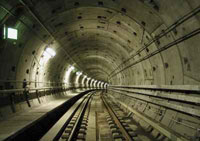Stalin’s secret metro can be open for public in Moscow
The Government of Moscow, Russia, has recently approved the concept for development of underground territories of the city where roads, parking areas and shopping malls are to be built. Besides, construction of another ring metro line located two or three spans away from the existing one is to be considered this summer.

The tremendous plans will inevitably lead to contacts with special services that are in charge of the secret system of metro tunnels of many kilometers, shafts and bunkers that were built under the surface for VIPs of the Soviet epoch, Russia’s Izvestia newspaper reports.
Writer Vladimir Gonik has been exploring Moscow’s underground territories for 25 years already; he coined a new term “Metyro-2” in the 1990s and wrote a novel titled “Preispodnyaya” (The Nether World). He described everything that was located under the territory of Moscow in such a detailed way that he was even summoned for unpleasant conversations with special services.
Gonik says that the secret metro lines can and must be used to relieve the main metro of its too dense traffic. Tunnels of the both metro lines look identical; they have the same diameter and the same infrastructure. The only peculiarity of Metro-2 is sunken rails that were done purposefully for those situations when underground tunnels could be used for motor transport.
The writer also states that several of the secret metro lines are already opened, the underground part of the Moscow metro’s Filevskaya Line, for instance. Originally, the line was built to take VIP passenger to Stalin’s near out-of-town residence. The construction of the line was partially finished but for some reason the project was stopped. Besides the tunnels there are other objects of the secret metro that can be used for Moscow’s good. There are metro stations that were never opened. Before the Tverskaya metro station appeared in Moscow, construction of a new station, Sovetskaya (Soviet), was started between the Mayakovskaya and Teatralnaya stations. The station actually exists nowadays; it is located right opposite the Moscow City Administration but it does not function. The station was reconstructed into a secret object, a Civil Defense Center.
There are tens of hollows underneath Moscow that appeared during construction of the regular metro. Majority of them were made for construction of the earliest metro lines as the primitive engineering techniques of that time required making special adits, extra tunnels, drifts and faces. Nowadays these hollows could be used as underground parking lots. Or they can be also used for delivery of goods by big autos to stores located on crowded streets which could become a good solution for the traffic jam problem there.
If the Moscow authorities fail to find a new application of the underground areas they may at least convert them into museums, writer Gonik says. They may follow the example of the US that opened the Presidential Bunker in Virginia or the Congress Bunker in West Virginia for public.
Mikhail Poltoranin, vice-premier of the Russian Government in 1990-1992, says that the secret metro line also includes a network of tunnels and an extra command post that can be used for controlling the country’s nuclear weapons in case of war. Lots of people necessary for maintaining of the secret command post could also take shelter there. The official says that there is no need to use the Metro-2 for surviving in case of a nuclear war. So, the closed underground lines can be used for civil purposes.
The Protocol Chief of Soviet President Mikhail Gorbachev and first Russian President Boris Yeltsin, Vladimir Shevchenko insists that the Metro-2 underground lines cannot be used until they are properly repaired. Underground pipelines that abound there are dilapidated and need extensive repairs.
Today, Moscow’s underground systems are a combination of historical and modern underground vaults. It was in the 1780s that the existence of underground passages, vaults, stream canals and casemates in Moscow was for the first time officially mentioned in printed sources and was supplied with detailed maps.
Basically, the secret underground vaults were meant for the restricted use of members of the Communist Party Central Committee and the Political Bureau. Large-scale construction was started under Moscow before and after WWII where bunkers, storage facilities and electric power stations appeared. Well-equipped shelters were constructed deep under the surface when nuclear and thermonuclear weapons were invented. Transport tunnels going from the centre of Moscow to its outskirts appeared then.
Every member of the Political Bureau had an apartment in the central bunker, and those were rather spacious quarters of about 180 square meters each. Those apartments included a private office, a rest room, bathroom and WC and rooms for cooking and eating meals. It is known that an underground private office of Soviet leader Leonid Brezhnev looked very much like the one located on the surface. Designers did their best to arrange the new office so that the party leader could feel less discomfort when in the bunker deep under the surface. Candidates of the Political Bureau also had their quarters in the secret tunnels but they were smaller and less comfortable than the rooms meant for top leaders.
But in fact members of the Political Bureau never used the bunkers, and majority of them never saw the quarters at all. Soviet leader and Secretary General of the Soviet Communist Party Leonid Brezhnev came down to the main bunker just once in the early 1970s and was really delighted with everything he saw there. Even though the quarters were meant for short staying there they were made particularly luxurious.
Construction of the bunkers took several decades, but the entire of the system was never completed. About eighty percent of the construction was finished by the moment of the breakup of the Soviet Union.
Translated by Maria Gousseva
Pravda.ru
Subscribe to Pravda.Ru Telegram channel, Facebook, RSS!


